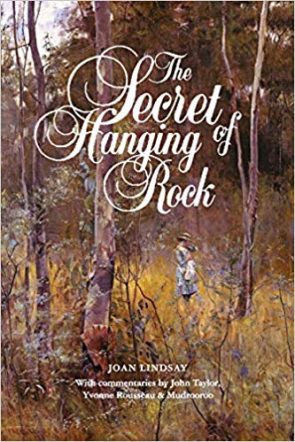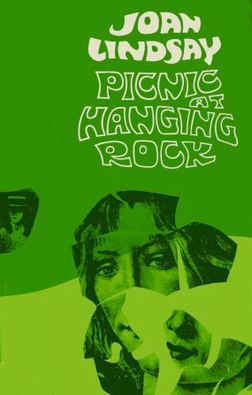
This is the supposed eighteenth chapter to Joan Lindsay’s Picnic At Hanging Rock, solving the mystery of what happened to the missing women.
I say “supposed” because the internet is rife with conspiracy theories that Joan Lindsay didn’t write it, that it’s a hoax, et cetera.
I’m not convinced. The number of parties necessary to orchestrate such a fraud (Lindsay’s estate, editor, publisher, surviving relatives, and so on) would be large, and the prose reads like Lindsay’s (for example, the usage of “little” in its diminutive/feminine sense.) Its contents also comport with what we know of Lindsay’s literary interests. Until I see evidence otherwise, I take Secret at face value: the unpublished work of Joan Lindsay.
It’s understandable that people would want to decanonize The Secret of Hanging Rock. Everyone who reads it reacts with disappointment. I don’t know of a single person who thinks it improves the book. It’s a few pages long, and much of its text was retrofitted into chapter 3 of Hanging Rock. In short, the girls disappeared into a rift in time. There are some gestures towards quantum cosmology, as well as Aboriginal “dreamtime” and therianism. That’s it.
It’s a bad, unsatisfying ending, one level above “a wizard did it”. Hanging Rock is a “who killed Laura Palmer?” type of story – the mystery’s the entire point, and explaining the mystery kills the story stone dead. You’re not supposed to know where the girls went. Hanging Rock was like a crossword puzzle in a newspaper: fun until you solve it, then it becomes a fish-wrapper.
Secret is so threadbare and underwhelming that I started pondering other things: such as the ethics of publishing a dead writer’s unfinished work. Nirvana fans are familiar with this game: every few years someone finds a shoebox of tapes and we’re subjected to yet another posthumous Kurt Cobain “album” containing abandoned scraps of music that he definitely wouldn’t have wanted the public to hear.
Is it right to do this? Release all of a famous artist’s outtakes once they’re too dead to complain?
I can see the opposite argument; authors don’t have unlimited fiat to declare that nobody read their work, particularly when it relates to something of public or literary importance (like Picnic at Hanging Rock). Consider Anne Frank’s diary. If someone wrote the cure for cancer on a piece of paper and commanded the world to never read it, we probably shouldn’t honor that request, either.
At the end, Hanging Rock was about time, and how time blurs reality. Reading the book is a maddening experience: you know that whatever happened to the girls, it’s knowledge out of your reach. Knowing what happens yanks the story back down to earth, and destroys its appeal. Hanging Rock left you like Aesop’s fox, snapping at grapes that are just out of reach. Secret cuts down the tree and lets you gorge on grapes until you’re become violently sick. Enjoy your stomach-ache.

Picnic at Hanging Rock is an classic in Australian psychological horror. It’s a genuinely disturbing book, and thinking about it makes me feel queasy and cold. It’s also Australia’s Blair Witch: a literary stunt that left its own provenance unclear. Many thought that the book told a true story, and even now you’ll meet folk who talk about the “Hanging Rock mystery” as if it really happened.
Hanging Rock was written in 1967 but is set over half a century earlier at a girls’ boarding school in Victoria. A group of four people (three students and teacher), leave a picnic to explore the nearby Hanging Rock formation. Three are never seen again. The fourth is discovered days later, nearly dead from sunstroke. When she recovers, she has no memory of what happened to the others.
The rest of the book is the community coming to terms with the mystery. A bloodhound fails to find the missing women, as does a local “black tracker”. An army of well-meaning volunteer searchers blankets Hanging Rock in footprints and trail-marks, trampling whatever evidence might have existed. The final people to see the party report some odd things: the three students were in a trancelike state, with staid mathematics teacher Greta McShaw literally undressed to her underwear. The reader actually follows the girls until the final moment, and knows some additional facts that the other characters don’t. But ultimately, we don’t know the full truth either.
Whatever happened at Hanging Rock (and there are signs that some characters know more than they are telling), the lack of resolution is like a thorn embedded in the community’s collective flesh, driving them frustration and to madness and then to further tragedy.
The events of the story bear an odd resemblance to Finland’s Lake Bodom murders, where three backpackers were slaughtered, with the sole survivor possessing no memory of the night’s events. Bodom happened in 1960, but I doubt Joan Lindsay was aware of it. Finland is far from Australia, and was further still in 1967. The world was much bigger then.
And unlike the United States (where a Bodom-style incident would have inspired sixteen made-for-TV movies, a Netflix series by Jordan Peele, and teenage girls obsessed with finding and marrying the killer), Finland isn’t culturally fascinated by tales of violent crimes, nor does it possess the regency to spread them all over the world.
Like Lake Bodom, Hanging Rock exists in the real world. I learned some interesting things about it on Wikipedia. It’s more properly called Mount Diogenes, after the Greek philosopher who held that civilisation is corrupt and nature is moral. Geologically, Hanging Rock is a mamelon, after the French word for nipple (is it important, in light of this, that all the main characters are female?)
Joan Lindsay does a good job of making Hanging Rock sound old-fashioned. Like any turn-of-the-century novelist, she almost puts on a pair of white gloves and chaperones you through the pages. This is the sort of book where you read sentences like “All this was nearly six years before this chronicle begins”. Only a few anachronistic words betray the book’s modernity – such as “deadbeat”, American slang that entered common usage in the 1940s.
When you climb Hanging Rock, you ascend a to a sharp point and then descend down gently rolling hills. The book’s structure is a little like that: the climax arrives in the first three chapters, and the rest of the book is a gradual come-down. Some readers find this anticlimactic, but to me it adds to the book’s sense of unease. As you read on, you realise you are wandering further from knowing what happened. You aren’t solving the mystery, you’re anti-solving it! It’s as if the answer to the puzzle is a solid island, and the book is an ocean dragging you ever further away. It’s agonizing, and compelling.
So, do we ever learn what happened? Do we even get a look through a crack in the door? Make up your own mind, but maybe there’s a reason they call it mystery fiction as opposed to solution fiction.

One of the final books in Gemmell’s Drenai setting, White Wolf introduces a new hero called Skilgannon the Damned.
It’s all here: the fast pace, the brutal fight scenes (Gemmell knows sixty adjectives for an axe splitting a skull), the terse and efficient characterization, the unabashed heroism, and the tension between ideals of good and evil and the complexities of reality. I truly believe that nobody ever did it better.
But “it’s all here” doesn’t feel like an unalloyed compliment, not after twenty five books of mostly the same stuff. Gemmell was an excellent but limited author, and here he paints within the lines, offering up mostly familiar pleasures. The result is a book that, while fun, doesn’t particularly need to exist.
All the usual baddies make an appearance – the Nadir, werebeast “Joinings”, assassins, shamans – as do the typical Gemmell action setpieces (here we get three fights in a tavern as opposed to the usual one or two). Once again, a character renounces their violent ways and tries to become a monk, with predictably disastrous results. And the final encounter, while exciting, couldn’t be more of a videogame boss battle if “One Winged Angel” was playing in the background.
The protagonist Skilgannon poses a particular problem: he’s just a jumble of traits from past Gemmell heroes and never emerges as a compelling and unique character. He has Waylander’s dark past, Druss’s demon-possessed weapon (the actual Druss appears in this novel, muddling things still further), Jon Shannow’s sense of having outlived his time, Tenaka’s sense of being ill-used by someone he trusted, etc. He’s supposed to be an antihero, but he only commits evil acts because of a pair of mind-controlling swords, a bit of thematic oddness that Gemmell never addresses.
Gemmell doesn’t do anything new here, but he does turn up the emotional intensity in a few places. The scenes depicting Skilgannon’s youth were fascinating, linking past Gemmell figures such as Gorben and Michanek and adding a host of new ones. Druss the Legend steals the show every time he appears, to the point where I wished the entire book was about him. And the title’s full meaning is actually pretty interesting, particularly in light of the sequel, The Swords of Night and Day.
I enjoyed White Wolf, both when I read it here and when I read its various bits and pieces in earlier books like Waylander et al. It was probably for the best that Gemmell spent his final years writing quasi-historical fiction (re-telling the Iliad). It forced him outside of his comfort zone. Gemmell incapable of writing anything but a Gemmell novel, but many of his best stories happened when he at least tried.



